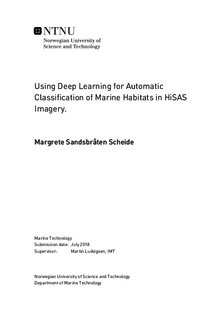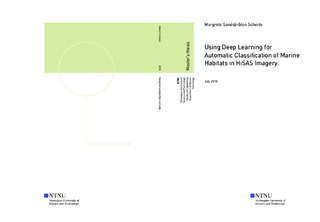| dc.description.abstract | This thesis aims to utilize an established image classification method to create a methodology for classifying cold-water corals in synthetic aperture sonar imagery. This will be performed by combining high-resolution sonar imagery with a convolutional neural network classification algorithm. The result will be an automatic classification model that will decrease the need for human interpretation of the sonar images. The method can be used for quantification of marine habitats in sonar imagery.
A case study was performed with three data sets from the Tautra area in the Trondheim fjord. The data sets are from 2012, 2013 and 2017. Most of the data was used to form a dataset with sub-images of 100x100 pixels used to train a CNN model. The rest of the images were saved for verification of the classification performance. The estimated accuracy on the verification images were 83%, 92% and 95% for 2012, 2013 and 2017 respectively.
A fourth case study was performed on sonar imagery from Nord-Leksa, another region of the Trondheim fjord, which was used to verify the classification performance on a different area than the Tautra ridge. The accuracy of the Nord-Leksa verification image was 89\%.
An estimate of the coral coverage for each data set was made, but the results could not be compared because the total area coverage for each year differed. The estimated coral coverage was 0.8 km2, 0.4 km2 and 0.7 km2 for the 2012, 2013 and 2017 Tautra data sets. The classified sonar mosaics showed a dense region of coral in locations where coral reefs have previously been verified. The Nord-Leksa coverage was estimated to be 2.3 km2, approximately 50% of the total area covered. Similarities of verified coral reefs and the predicted coverage from the classification model occurred in the Nord-Leksa case study as well.
Two sources of error in the methodology was identified. The random initialization of the neural network weights and the random shuffling of the training data set before each epoch of training caused some local variations in CNN accuracy. The model used to classify sonar imagery for this thesis reported an accuracy of 95%, with an expected 2-3\% variation caused by the aforementioned reasons. | |

